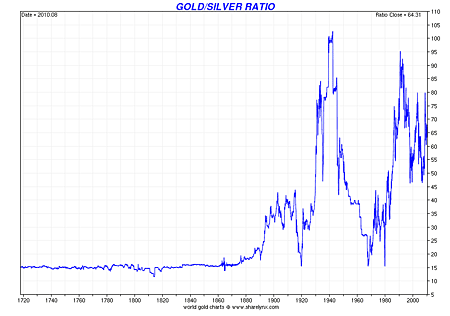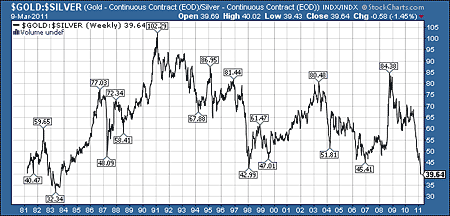Are gold and silver warning us of a new stage in the financial crisis?
Silver is more expensive compared to gold than at any point since 1984. So is silver finally 'shooting for the moon'? Or is this move warning of a new phase in the financial crisis? Dominic Frisby investigates.
The earth's crust contains something like 0.08ppm (parts per million) silver. There is, on the other hand, just 0.004ppm gold. In other words silver is about 20 times more abundant in the earth's crust than gold.
The historical monetary ratios between the two metals pretty much reflected this. It varies according to time and place, but on average it seems roughly 16-18 silver coins were exchangeable for a gold coin of the same weight wherever or whenever you were.
In 2009, about 80 million ounces of gold were produced and, according to the Silver Institute, 709 million ounces of silver about nine times more.
MoneyWeek
Subscribe to MoneyWeek today and get your first six magazine issues absolutely FREE

Sign up to Money Morning
Don't miss the latest investment and personal finances news, market analysis, plus money-saving tips with our free twice-daily newsletter
Don't miss the latest investment and personal finances news, market analysis, plus money-saving tips with our free twice-daily newsletter
But gold is not nine times more expensive than silver. Nor is it 16, 18 or 20 times more expensive than silver. It is 40 times more expensive.
That seems rather a lot, especially when you consider that most of the gold that has ever been mined remains in the world, yet much of the silver has been consumed by industry.
Is that ratio normal? Or is it some kind of anomaly? Let's have a look
Silver looks expensive but only by recent standards
If we look back at the last 35 years, that 40 level for the gold:silver ratio is not only not normal, it's in fact extreme: silver is unusually expensive relative to gold, at least by the standards of recent history.
But this hasn't always been the case. Let's look first at historical chart of the ratio over the last 300 years. My thanks, as always, go to Nick Laird of Sharelynx. When the ratio is low, silver is expensive relative to gold; when it is high, silver is cheap.

As you can see, since the early 18th century, not long after the formation of the Bank of England, that ratio was fairly constant just around the 17:1 area. Then, in the mid-1870s, it began to climb. The old 17:1 ratio would not be seen for a generation.
The ratio became extremely volatile and, in the early 20th century, hit highs at around the 42 to 43:1 area. But, thanks to World War I, by 1920 it had come all the way back to 17:1.

Claim your FREE report: The 6-step game-plan for
spread betting profits
This didn't last. By the 1930s, the ratio had climbed to 85, before capitulating briefly to the 45 area. Then, when WWII was in mid-flight, the ratio went above 100.
But 25 or so years later, come the late '60s, and the ratio fell back at 17, its historical 'norm'. It spiked back to that 40-45 level in the 1970s, before falling below 20 in the notorious spike of 1980 when silver went to $50.
Silver is more expensive relative to gold than in nearly 30 years
Since 1984 that ratio has never fallen below 45.
Until last week, that is. When it dropped to 39.

Why is that important?
Because you can see that, from the above charts, the 40-45 area has been a pivotal technical level. There are periods or cycles in history when the gold:silver ratio trades above it: 1932 to 1960 and 1984 till now. And there are periods when it has traded below, such as around 1963 to 1984, and pre-1930.
So I was terribly excited to see that $40 level breached. I thought we might be re-entering a cycle at the end of which silver's 'true value' would once again be recognised. If we were entering such a period, it might be that within a few years we would see that ratio below 20, once again, finally reflecting the amount of silver there actually is in the world relative to gold. Were that ratio to do that and head back to 17, and the gold price to remain unchanged at around $1,400, we'd be looking at $80 silver. Nice work if you can get it.
Is this the beginning of the next phase of the financial crisis?
But, as I have said many times, silver has a nasty habit of disappointing. On breaching that 40 level on the ratio, silver has hit a wall. Yesterday it was down about 2%. And, it wasn't just silver. Gold was down, the FTSE too, the Dow, commodities you name it. The junior resource sector has been absolutely annihilated this past week.
It could be that this turn down is the beginning of the next phase of the financial crisis. It wouldn't surprise me. It's long-overdue and there are bearish signals all over the place. Senior gold stocks have been in a downtrend since late last year, even although gold has been rising. Emerging stock markets have been falling, although their Western counterparts have been rising. And a spike down in the gold:silver ratio often marks a major market turn.
Or it could be that this is just a temporary stumbling block on the inevitable road back to that magical 17:1 ratio.
For my own part, I think the ratio is heading a lot lower eventually. The key is that last word, 'eventually'. Look at the run silver has had since August. Look at that last spike down in the gold:silver ratio. I would venture that much of that needs to be retraced, just as it was in early 1998 and 2004, when the gold:silver ratio had similar runs to now. (They're worth studying in the chart above).
Our recommended article for today
The UK manufacturers building a trillion-dollar plane fleet
The Commercial Aircraft Corporation of China aims to become one of the world's biggest manufacturers of commercial airliners over the next two decades. And these two London-listed engineers look set to profit along with them, says Tom Bulford.
Get the latest financial news, insights and expert analysis from our award-winning MoneyWeek team, to help you understand what really matters when it comes to your finances.
MoneyWeek is written by a team of experienced and award-winning journalists, plus expert columnists. As well as daily digital news and features, MoneyWeek also publishes a weekly magazine, covering investing and personal finance. From share tips, pensions, gold to practical investment tips - we provide a round-up to help you make money and keep it.
-
 Rightmove: Biggest January rise in property asking prices in 25 years
Rightmove: Biggest January rise in property asking prices in 25 yearsThe traditional Boxing Day bounce and post-Budget positivity combined to create a 2.8% jump in property asking prices, data suggests
-
 PayPoint: A promising stock for income-seekers
PayPoint: A promising stock for income-seekersPayPoint, a household name across Britain, is moving away from its traditional roots toward a digital future. Investors after a steady income should buy in

